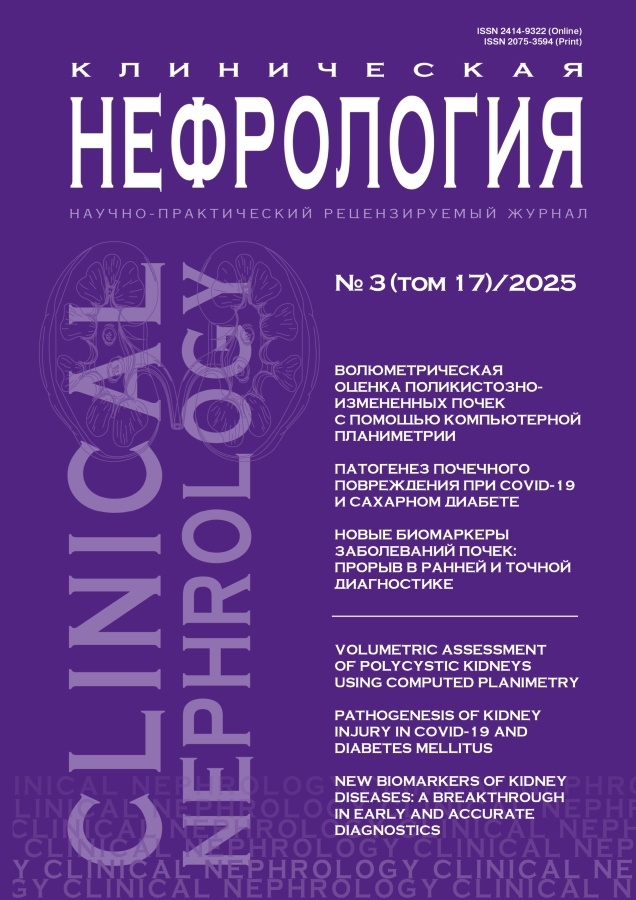Pathogenesis of kidney injury in COVID-19 and diabetes mellitus: a review of current concepts
- Authors: Abdurakhimov A.K.1
-
Affiliations:
- Andijan State Medical Institute
- Issue: Vol 17, No 3 (2025)
- Pages: 81-84
- Section: Literature Reviews
- Published: 10.10.2025
- URL: https://journals.eco-vector.com/2075-3594/article/view/692786
- DOI: https://doi.org/10.18565/nephrology.2025.3.81-84
- ID: 692786
Cite item
Abstract
Acute kidney injury (AKI) is a common complication in patients with COVID-19, as confirmed by numerous studies. The prevalence of AKI in COVID-19 varies widely (0,5–80,3%) depending on the severity of the disease. AKI in COVID-19 can be caused by both direct viral effects on the kidneys and an excessive inflammatory response of the body (cytokine storm), as well as hypoxemia and coagulopathy. Direct kidney damage by SARS-CoV-2 via ACE2 receptors in the renal epithelium can lead to tubular and glomerular damage, increasing inflammation and impairing renal function. Also, in patients with diabetes mellitus (DM), these processes can be further aggravated by diabetic nephropathy, which makes the kidneys more vulnerable to damage in COVID-19. Despite this, the classical diagnostic method based on creatinine levels does not have high specificity for the early detection of AKI, since even with a 50% decrease in kidney function, creatinine levels can remain within the normal range. This can lead to late diagnosis of AKI, reduced treatment effectiveness and increased mortality rates. Therefore, further studies to assess the diagnostic accuracy and prognostic value of new markers for the early detection of AKI in patients with COVID-19 are required. This review covers key aspects such as the prevalence and clinical and morphological forms of kidney injury in COVID-19, pathogenetic mechanisms of kidney injury in COVID-19, pathogenetic mechanisms of kidney injury in diabetes mellitus and modern markers for the diagnosis of acute kidney injury in patients with diabetes mellitus and COVID-19. For this review, 25 sources from the PubMed, Google Scholar and CyberLeninka databases were used.
Keywords
Full Text
About the authors
Abduhalim K. Abdurakhimov
Andijan State Medical Institute
Author for correspondence.
Email: abduhalimaka@mail.ru
ORCID iD: 0000-0003-4541-0436
Teaching Assistant of the Department of Internal Medicine
Uzbekistan, AndijanReferences
- Abdurakhimov A., Kakharov Z. Pathogenetic role of coronavirus infection in the development of acute kidney injury. Am J Med Med Sci. 2024;14(6):1673–9. doi: 10.5923/j.ajmms.20241406.44.
- Абдурахимов А.Х. Анализ демографических, клинических и лабораторных показателей у пациентов с COVID-19 с острым повреждением почек. Клиническая нефрология. 2025;1(1):33–6. [Abdurakhimov А.Kh. Analysis of demographic, clinical and laboratory parameters in COVID-19 patients with acute kidney injury. Clinical nephrology. 2025;1(1):33–6 (In Russ.)]. Doi: https://dx.doi.org/10.18565/nephrology.2025.1.33-36.
- Huang I., Lim M.A., Pranata R. Diabetes mellitus is associated with increased mortality and severity of disease in COVID-19 pneumonia – a systematic review, meta-analysis, and meta-regression. Diab. Metab. Syndr. 2020;14(4):395–403. doi: 10.1016/j.dsx.2020.04.018.
- Chen X., Hu W., Ling J. et al. Hypertension and diabetes delay the viral clearance in COVID-19 patients. MedRxiv. 2020. doi: 10.1101/2020.03.22.20040774.
- Drucker D.J. Coronavirus infections and type 2 diabetes—shared pathways with therapeutic implications. Endocr. Rev. 2020;41(3):13. doi: 10.1210/endrev/bnaa011.
- Walls A.C. et al. Structure, function, and antigenicity of the SARS-CoV-2 spike glycoprotein. Cell. 2020;181(2):281–92. doi: 10.1016/j.cell.2020.02.058.
- NCBI. Gene expression. [Internet]. Retrieved from https://www.ncbi.nlm.nih.gov/gene/59272#gene-expression.
- Puelles V.G. et al. Multiorgan and renal tropism of SARS-CoV-2. N. Engl. J. Med. 2020;383(6):590–2. doi: 10.1056/nejmc2011400.
- Fu H., Liu S., Bastacky S.I. et al. Diabetic kidney diseases revisited: A new perspective for a new era. Mol. Metab. 2019;30:250–63. doi: 10.1016/j.molmet.2019.10.005.
- Ma M., Wan X., Gao M. et al. Renin-angiotensin-aldosterone system blockade is associated with higher risk of contrast-induced acute kidney injury in patients with diabetes. Aging (Albany NY). 2020;12(7):5858. doi: 10.18632/aging.102982.
- Patel D.M., Bose M., Cooper M.E. Glucose and blood pressure-dependent pathways—the progression of diabetic kidney disease. Int. J. Mol. Sci. 2020;21(6):2218. doi: 10.3390/ijms21062218.
- Fouad M., Salem I., Elhefnawy K. et al. MicroRNA-21 as an early marker of nephropathy in patients with type 1 diabetes. Indian J. Nephrol. 2020;30(1):21–5. doi: 10.4103/ijn.IJN_80_19.
- Mourad D., Azar N.S., Azar S.T. Diabetic nephropathy and COVID-19: The potential role of immune actors. Int. J. Mol. Sci. 2021;22(15):7762. doi: 10.3390/ijms22157762.
- Xu S.W., Ilyas I., Weng J.P. Endothelial dysfunction in COVID-19: an overview of evidence, biomarkers, mechanisms and potential therapies. Acta Pharmacol. Sin. 2023;44(4):695–709. doi: 10.1038/s41401-022-00998-0.
- Ye Q., Wang B., Mao J. The pathogenesis and treatment of the cytokine storm in COVID-19. J. Infect. 2020;80(6):607–13. doi: 10.1016/j.jinf.2020.03.037.
- Sorokin A.V. et al. COVID‐19 – Associated dyslipidemia: Implications for mechanism of impaired resolution and novel therapeutic approaches. FASEB J. 2020;34(8):984–53. doi: 10.1096/fj.202001451.
- Xu T., Sheng Z., Yao L. Obesity-related glomerulopathy: pathogenesis, pathologic, clinical characteristics and treatment. Front. Med. 2017;11:340–8. doi: 10.1007/s11684-017-0570-3.
- Garvin M.R., Alvarez C., Miller J.I. et al. A mechanistic model and therapeutic interventions for COVID-19 involving a RAS-mediated bradykinin storm. eLife. 2020:16. doi: 10.7554/eLife.59177.
- Vuorio A., Raal F., Kaste M., Kovanen P.T. Familial hypercholesterolaemia and COVID-19: A two-hit scenario for endothelial dysfunction amenable to treatment. Atherosclerosis. 2021;320:53–60. doi: 10.1016/j.atherosclerosis.2021.01.021.
- Op de Beeck A., Eizirik D.L. Viral infections in type 1 diabetes mellitus—why the β cells? Nat. Rev. Endocrinol. 2016;12(5):263–73. doi: 10.1038/nrendo.2016.30.
- Delabranche X., Helms J., Meziani F. Immunohaemostasis: a new view on haemostasis during sepsis. Ann. Intensive Care. 2017;7:1–14. doi: 10.1186/s13613-017-0339-5.
- Nougier C., Benoit R., Simon M. et al. Hypofibrinolytic state and high thrombin generation may play a major role in SARS-CoV-2 associated thrombosis. J. Thromb. Haemost. 2020;18(9):2215–9. doi: 10.1111/jth.15016.
- Jhaveri K.D., Meir L.R., Flores Chang B.S. et al. Thrombotic microangiopathy in a patient with COVID-19. Kidney Int. 2020;98(2):509–12. Doi: 10.1016/ j.kint.2020.05.025.
- Legrand M., Bell S., Forni L. et al. Pathophysiology of COVID-19-associated acute kidney injury. Nat. Rev. Nephrol. 2021;17(11):751–64. doi: 10.1038/s41581-021-00452-0.
- Fignani D., Licata G., Brusco N. et al. SARS-CoV-2 receptor angiotensin I-converting enzyme type 2 (ACE2) is expressed in human pancreatic β-cells and in the human pancreas microvasculature. Front. Endocrinol. 2020;11:19. doi: 10.3389/fendo.2020.596898.
Supplementary files








